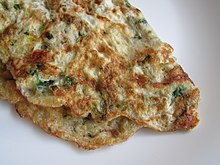 Indian omelette | |
| Place of origin | India |
|---|---|
| Associated cuisine | Indian |
| Main ingredients | Egg, onions, green chillies, tomatoes |
An Indian omelette or masala omelette is a variant of the omelette originating from India. Its main ingredients are eggs, herbs, tomatoes and spices that vary by region.[citation needed]
Grated cheese is sometimes put over the omelette, and they may also be filled with things such as shrimp and/or chicken flavoured with curry.[1]
The omelette commonly includes finely chopped green chili peppers and onions (or shallots), finely chopped fresh green coriander, salt, and zeera (cumin). Variations include grated coconut, ground black pepper, curry leaves, and finely chopped tomatoes.[2] Grated cheese may also be added. The egg mixture is whisked until fluffy and then cooked on a skillet. Usually the skillet is not warmed much before the mixture is poured in and it does not immediately solidify. The stove is usually turned on right before the egg is poured in.
George Frederick Scotson-Clark, the author of Eating Without Fears, described it as "an excellent late supper dish."[1]
See also[edit]
- Tomato omelette (Chickpea flour-based, not egg-based)
References[edit]
- ^ a b Scotson-Clark, George Frederick (G.F.). Eating Without Fears. N.L. Brown, 1923. p. 19. "An Indian Omelette has curried shrimps, eggs or chicken folded in it, and over it is sifted grated cheese. This is an excellent late supper dish."
- ^ www.manjumalhi.co.uk/recipes/vegetarian/indian-omelette.html Accessed 2009-01-21. Archived August 20, 2008, at the Wayback Machine
Well, that’s interesting to know that Psilotum nudum are known as whisk ferns. Psilotum nudum is the commoner species of the two. While the P. flaccidum is a rare species and is found in the tropical islands. Both the species are usually epiphytic in habit and grow upon tree ferns. These species may also be terrestrial and grow in humus or in the crevices of the rocks.
View the detailed Guide of Psilotum nudum: Detailed Study Of Psilotum Nudum (Whisk Fern), Classification, Anatomy, Reproduction